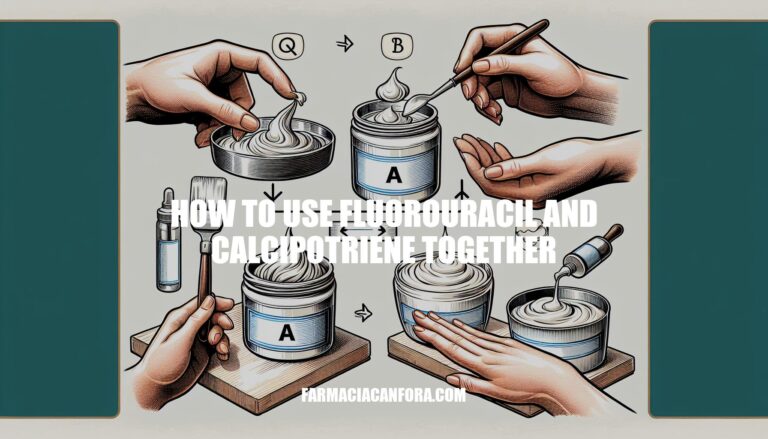Here’s a brief introduction and overview:
Introduction:
Fluorouracil and calcipotriene-4-day-treatment”>calcipotriene are topical medications often used together to treat actinic keratosis, a precancerous skin condition caused by sun damage.
How to Use:
- Clean the Area: Wash the affected skin with soap and water, then gently scrub away any crust or flakes.
- Apply the Cream: Mix fluorouracil (5%) and calcipotriene (0.005%) in equal parts. Apply a thin layer to the affected area twice daily (morning and night).
- Wash Hands: After application, wash your hands thoroughly.
- Moisturize: If your skin feels irritated or dry, you can apply a moisturizer or Vaseline.
Purpose and Benefits:
- Purpose: This combination targets and destroys abnormal skin cells, reducing the risk of these cells developing into skin cancer.
- Benefits: The treatment is effective in reducing the number of actinic keratoses and can lead to shorter treatment durations compared to using fluorouracil alone.
If you have any more questions or need further details, feel free to ask!
Mechanism of Action
Here’s a concise explanation:
Fluorouracil (5-FU):
- Mechanism: Fluorouracil is a pyrimidine analog that inhibits thymidylate synthase, disrupting DNA synthesis and causing cell death. It also incorporates into RNA, interfering with RNA function.
Calcipotriene (Calcipotriol):
- Mechanism: Calcipotriene is a synthetic vitamin D3 analog that binds to vitamin D receptors, modulating the immune response and promoting differentiation of keratinocytes.
Synergistic Effects:
- Combined Action: When used together, fluorouracil induces an inflammatory response that targets abnormal cells, while calcipotriene enhances the immune system’s ability to recognize and attack these cells. This combination leads to a more effective and shorter treatment duration, with a robust immune response against precancerous cells.
Preparation and Application
Here are the steps to prepare and apply fluorouracil and calcipotriene together:
Materials Needed:
- Fluorouracil 5% cream
- Calcipotriene 0.005% ointment or cream
- Soap and water
- Washcloth
- Gloves (optional)
Steps:
- Clean the Area: Wash the affected area with soap and water. Use a washcloth to gently scrub away any crust or flakes.
- Mix the Creams: In a 1:1 weight ratio, mix fluorouracil 5% cream with calcipotriene 0.005% ointment or cream.
- Apply the Mixture: Apply a thin layer of the mixed cream to the affected areas using your fingertips. If you prefer, you can wear gloves to avoid direct contact.
- Wash Hands: After application, wash your hands thoroughly to remove any residue.
- Frequency: Apply the mixture twice daily for 4 to 6 consecutive days every 2 weeks.
Precautions:
- Avoid Sun Exposure: Treated areas can become more sensitive to sunlight. Use sunscreen and wear protective clothing.
- Monitor Skin Reaction: Look out for severe redness, blistering, or peeling. If these occur, stop the treatment and consult your healthcare provider.
- Avoid Sensitive Areas: Do not apply the cream near the eyes, mouth, or open wounds.
If you have any concerns or experience severe side effects, it’s important to contact your healthcare provider.
Dosage and Frequency
For the combination of fluorouracil (5-FU) and calcipotriene:
- Fluorouracil (5-FU): Apply twice daily (morning and night) in an amount sufficient to cover the lesions until the inflammatory response reaches the erosion stage, typically between 2-4 weeks.
- Calcipotriene: Apply a thin layer to the treatment area twice daily, following the same schedule as fluorouracil.
Always wash your hands after application and consider using a moisturizer if your skin becomes irritated or dry.
Expected Results and Timeline
When using fluorouracil and calcipotriene together, the treatment typically follows this timeline and skin response:
- First Week: Application usually once or twice daily. By the end of the first week, expect significant inflammation, redness, and scaling.
- Second Week: Inflammation intensifies, leading to crusting, swelling, and excoriation. Symptoms like itching, burning, and stinging are common.
- Third to Fourth Week: The skin reaction peaks, with severe erythema and discomfort. This stage is crucial for the treatment’s effectiveness.
- Post-Treatment: After completing the course (typically 10-28 days), the skin begins to heal. Over the next few weeks, expect gradual improvement with reduced actinic keratoses and potential prevention of future skin cancers.
This combination treatment is known for its efficacy in reducing actinic keratoses and preventing squamous cell carcinomas.
Side Effects and Management
Common Side Effects of Using Fluorouracil and Calcipotriene Together
- Redness: This is very common and can last up to 10 days after treatment.
- Burning Sensation: Mild burning and itching are reported by about 40% of patients.
- Scaling: Skin scaling is another frequent side effect.
- Itching: Itching at the application site is also common.
Tips to Manage Side Effects
- Moisturize: Use a gentle, fragrance-free moisturizer to soothe the skin.
- Avoid Sun Exposure: Protect the treated area from direct sunlight by wearing protective clothing and using sunscreen.
- Cool Compresses: Apply cool compresses to reduce burning and itching.
- Hydration: Drink plenty of water to keep your skin hydrated.
- Gentle Cleansing: Use mild, non-irritating cleansers to wash the treated area.
If side effects persist or worsen, consult your healthcare provider for further advice.
To use fluorouracil and calcipotriene together for actinic keratosis treatment, follow these steps:
Clean the affected area with soap and water, then mix equal parts of 5% fluorouracil cream and 0.005% calcipotriene ointment or cream.
Apply a thin layer to the affected areas twice daily for 4-6 consecutive days every 2 weeks.
Wash hands thoroughly after application and consider using a moisturizer if skin becomes irritated or dry.
Monitor skin reaction, avoiding severe redness, blistering, or peeling.
If side effects persist or worsen, consult your healthcare provider.


